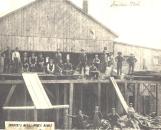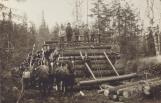14
This is a corduroy tote road in the Blind River area, used to access lumber camps. These roads were built by laying logs side by side and were very effective for use over swampy areas. In the Bruce Mines area, Carter Road in Plummer Township, was originally a corduroy road, but has been resurfaced for use today.Photograph courtesy of the Ontario Ministry of Northern Development and Mines.
© Queen's Printer for Ontario, 1907. Reproduced with permission.
16
Sawmills were established in the area with the early settlers. It is believed the first one was the Kay Brothers in 1896, located in the Rydal Bank area. Others were the Jack Brothers in Rydal Bank, Snyder's Mill in Bruce Mines, and McLarty's Sawmill in Plummer.Photo courtesy of the Bruce Mines Museum.
18
Photo courtesy of Jean Cooper.20
Photo courtesy of Merritt Strum.22
Photo courtesy of Merritt Strum.23
Free grants of crown land were created in the Free Grants and Homesteads Act in 1868. This would encourage settlement, and the clearing and cultivation of land unsuitable for mining or logging.Prerequisites:
1. Any married man with children under 18 yrs of age was entitled to occupy 200 acres of free crown land. He had to apply to the local government agent and sign an affidavit of intent to occupy the land and carry out the duties connected with it.
Within one month of the transaction completion, the land had to be occupied and improvements started.
After 5 yrs if 15 acres were cleared and under cultivation and he had a well-built, habitable house, he received a deed for the farm he created.
The Crown reserved the right to remove timber, gravel and minerals or build a road on this property at any time. To compensate for this, the original owner was exempt from taxes as long as it remained in his possession.
2. Any single man over 18, or a married man with no children, the same procedures and conditions applied, but they were entitled to 100 acres of land.
24
Early farmers had large families that worked the farm together. Grain crops were planted by hand, harvested by hand using a sickle or scythe, raked and piled into stacks, then hauled to the barn for storage.Sam West built the first 'sugar shack' around 1910. The West family was the biggest maple syrup producers in the area for several years.



